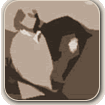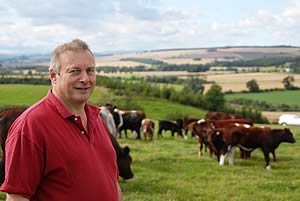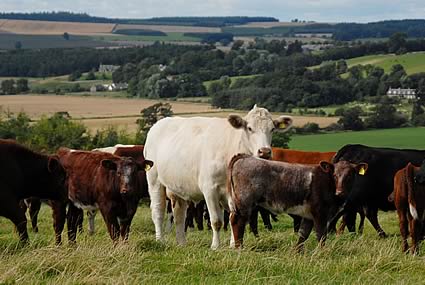 |
|||||||||
|
|||||||||||||||||||
|
|
Traditional
Breeds Key to Profitable Beef Production Traditional breeds of suckler cows which can be outwintered on the hill are the key to profitable beef production for James Playfair Hannay.
“We require cows which can live on fresh air – and produce a quality calf. The Aberdeen Angus and Beef Shorthorn have a big role to play,” he says. The 90-strong pure-bred Angus herd remains the ‘bread and butter’ of the cattle enterprise for Playfair Farms. “Everyone is grumbling that beef cattle are making no money but I don’t think many could keep cows cheaper than I can on the hill,” he says. James is the fourth generation of his family to farm at Morebattle Tofts and he also farms Clifton –on-Bowmont and more recently Yetholm Mains on a contract farming basis. Playfair Farms operates over 4,300 acres running 300 suckler cows and 2,000 principally North Country Cheviot breeding ewes. Six hundred arable acres grow malting barley and other cereals for home use as well as straw for bedding. A pedigree Aberdeen Angus herd was founded by James’s grandfather in 1947 and when James returned to the farm after college in the late 1970s he was so convinced about the attributes of native bred cattle that he founded a Beef Shorthorn herd. “When the continental terminal sire breeds came into the UK there were some wonderful native-bred suckler cows. Now these cows have all gone and we have the Holstein influence and the cows are too thin skinned and hungry. The capital output needed to keep them is too great which was fine when barley was cheap. I would also question whether our land had enough body to carry these bigger, heavier-boned continental cows.
“We tried different breeds of bulls on the cows but we found that with our system the Shorthorn cross Angus cow was the best, crossed to the Angus bull. The cow wasn’t too big and hungry at up to 700kg and she weaned as big a calf as any of the other crosses we had analysed and the decision was taken that we had better buy some Shorthorns. We were also getting a lack of uniformity.” At the time the Shorthorn breed was in decline, however several females were bought combining Northern Dairy Shorthorns from Cumbria as well as Beef Shorthorns from Parkfield and Ardbennie as well as dual purpose Shorthorns from Ronnie Henderson, of Newton. The purebred Shorthorn herd was established in the early 1980s, under the Tofts prefix as with the Angus herd, and now numbers 60 cows and the additional 150 commercial sucklers which are Shorthorn cross Angus. “We set out to produce bulls for our own use and we had no intentions of being ‘big’ in the pedigree world and going to Perth and winning championships,” said James, who is the Beef Shorthorn Association’s vice-president. However, at the Perth February bull sale this year the Tofts herd achieved its highest prices yet for Shorthorns with Tofts Hector making 8,000gns to a pedigree breeder and another bull making 5,500gns for a new herd in Northern Ireland. At the outset the breed’s genetic pool in the UK was small and cows were identified in Canada for embryo production. Another problem says James is that too few UK breeders performance record their herds – both the pedigree herds at Morebattle Tofts have been recorded for more than 20 years. “We have been criticised for using certain bulls but I haven’t used a bull where I haven’t seen a job for it to do,” he says. As well as using the traditional Beef Shorthorn and Dairy Shorthorn and Northern Dairy Shorthorn, bloodlines from the French Maine Anjou and polled Shorthorns from New Zealand, Australia and North America have been used. “As a breed, while it is doing the job, we have to be more selective – udders in cows need to be improved and feet and legs are starting to become a problem. Breeders buy bulls without seeing the parents. I have only used one bull which I haven’t seen its parents – a New Zealand bred bull – but I had seen its progeny. “The Beef Shorthorn is a maternal breed and the challenge is to breed good shaped cattle with an abundance of milk. In 2000 the neighbouring farm Yetholm Mains was taken on in a contract with the family who farmed it and this is where commercial cows now run all crossed with the Angus bull. Calves are sold either as yearling stores or finished off the farm, both having a ready market with Marks & Spencer, Waitrose and Costco. They are fed a wholecrop diet, a mix of lupins and triticale with minerals. Last year the steer calves averaged 13 months old producing 300kg carcases grading at R4L. Achieving this weight as soon as possible improves turnover. “Supermarkets have not been a great help generally in the red met industry and for the MLC, high value meat doesn’t seem to be of interest. When it encouraged producers to make beef leaner the consumption went down – it seemed the MLC’s purpose is to sell vast quantities of mince per hectare!” The cows are outwintered on the dry white hill which runs up to 1,300ft – the farm is in the second driest parish in Scotland with 23 to 25 inches of rainfall a year. Grass conservation is assisted with a deferred grazing system. Calving is in May in hill paddocks with weaning the following November when the calves are housed and the cows stay out on the hill. Through the winter the cows are fed 2kg a day of a barley and mineral home mix ration. The only supplement they are fed from then is a high magnesium mineral block. In September and October prior to weaning the calves are creep fed with a home-mix ration. The aim is to calve the heifers at two years old and for each to produce 10 living calves which when weaned off the hill must be a minimum of 300kg.
|
||||||||||||||||||

|
|
||||||||||||||||||
| home | agri-services | pedigree
pen | news | dairy | beef | machinery property | organisations | site map |
|||||||||||||||||||

Article by
Jennifer MacKenzie

